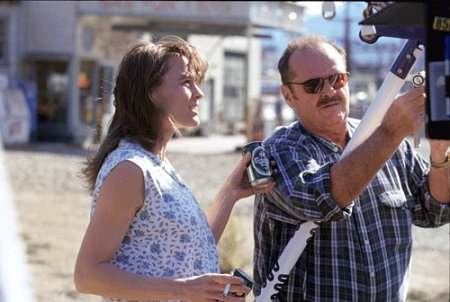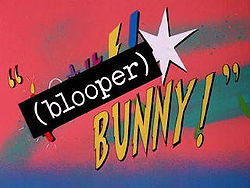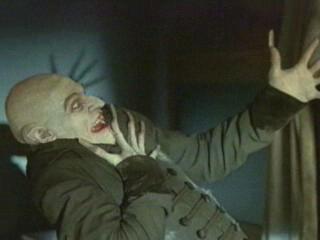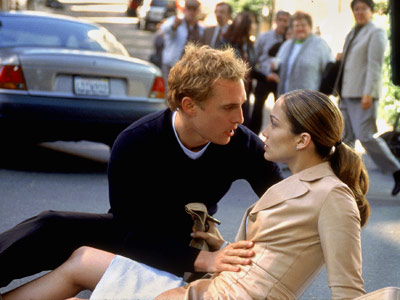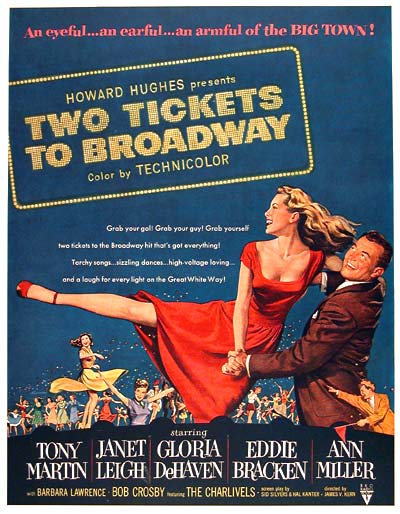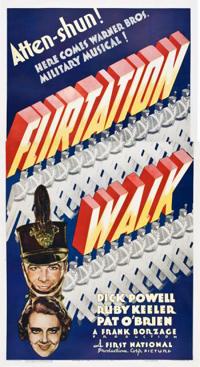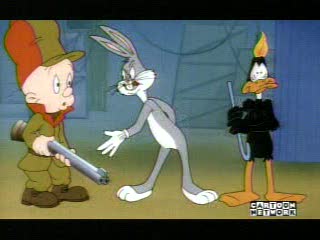From the Chicago Reader (January 26, 2001). — J.R.
The Pledge
***
Directed by Sean Penn
Written by Jerzy Kromolowski and Mary Olson-Kromolowski
With Jack Nicholson, Patricia Clarkson, Benicio Del Toro, Dale Dickey, Aaron Eckhart, Helen Mirren, Tom Noonan, Robin Wright Penn, Vanessa Redgrave, Mickey Rourke, and Sam Shepard.
Blooper Bunny
***
Directed by Greg Ford and Terry Lennon
Written by Ronnie Scheib, Ford, and Lennon
With Bugs Bunny, Daffy Duck, Elmer Fudd, and Yosemite Sam.
The Wedding Planner
**
Directed by Adam Shankman
Written by Pamela Falk and Michael Ellis
With Jennifer Lopez, Matthew McConaughey, Bridgette Wilson- Sampras, Justin Chambers, and Judy Greer.
Shadow of the Vampire
*
Directed by E. Elias Merhige
Written by Steven Katz
With Willem Dafoe, John Malkovich, Catherine McCormack, Eddie Izzard, Cary Elwes, and Udo Kier.
I can’t say that The Pledge, The Wedding Planner, Blooper Bunny, and Shadow of the Vampire have much in common, apart from the fact that they’re showing in Chicago this week. Yet all four do, to different degrees, feed off other movies. Frankly, that’s what I like most about The Wedding Planner — a romantic comedy starring Jennifer Lopez and Matthew McConaughey that aspires to and achieves the goofiness of a studio musical of the early 50s. And it’s what I like even more about Blooper Bunny (1991), a deconstructive eight-minute Bugs Bunny cartoon made for Warners that’s showing at the Film Center this Saturday and Sunday with Tom DiCillo’s 1995 Living in Oblivion as part of a thoughtful and intriguing series put together by programmer Martin Rubin called “New Narrative Order.” It puts a wicked spin on its many predecessors by being presented mainly in the form of outtakes from a fictional TV special, Bugs Bunny’s 51st 1/2 Anniversary Spectacular — including a tap-dance routine with Bugs, Elmer Fudd, and Daffy Duck and a layered cake sprouting skyrockets as well as Yosemite Sam.
What I like most about The Pledge, the third and best feature directed by Sean Penn — a somber character study featuring Jack Nicholson as a supposedly retired detective — isn’t so much what it borrows from other movies as how nimbly it bounces its premises off them, confounding expectations by avoiding the usual thriller payoffs to arrive at a few uncomfortable conclusions about the leading character’s blood lust as well as our own.
What I dislike most about Shadow of the Vampire is how it cannibalizes an earlier movie for no apparent reason. This stupid and demeaning fantasy about the shooting of F.W. Murnau’s 1922 masterpiece Nosferatu is a piece of postmodernist kitsch whose only redeeming quality is an enjoyably over-the-top, eye-rolling performance by Willem Dafoe as Max Schreck, the actor playing the lead vampire, Count Orlock.
One of the creepy aspects of the isolationism of contemporary Hollywood filmmaking is that filmmakers tend to reject the possibility of saying anything meaningful or fresh about American life at the outset. That leaves them with the options of trying to say something meaningful about other movies or trying simply to reproduce them. The latter is the modest and mainly successful task of The Wedding Planner, a comedy about a wedding planner (Lopez) falling for somebody (McConaughey) she meets quite by chance (he saves her life in a street accident) who turns out to be the designated groom in a wedding she’s planning. Every bit of this story can be traced back to big-studio B musicals half a century ago with actresses such as Janet Leigh, Gloria De Haven, and Jane Powell and actors such as Tony Martin, Bob Fosse, and Bobby Van; the guy who doesn’t get the girl is occasionally a Latino lounge lizard (played by someone like Fernando Lamas or Ricardo Montalban), and here he’s a cheerful working-class Italian with a thick accent (Justin Chambers). I find this movie charming because of my nostalgia for a brand of romantic treacle with highly photogenic leads that we don’t get much of nowadays — and because it acknowledges where it’s coming from, signaled by two trips to a San Francisco park with improbable outdoor screenings of the obscure vintage musicals Two Tickets to Broadway (1951, with Leigh, Martin, and De Haven) and Flirtation Walk (1934, with Dick Powell and Ruby Keeler). I can’t recommend it to anyone who wants a romantic comedy with more contemporary qualities, but I can recommend it if you’re on the prowl for old-fashioned glamour, schmaltz, and sexy infatuations.
Shadow of the Vampire neither reproduces nor has anything meaningful to say about Nosferatu. I suspect that what I dislike most about its cannibalizing is how contemporary in spirit it is. This exercise in glibness is predicated on the notion that Max Schreck was a real vampire, hired by Murnau (John Malkovich) in exchange for the blood of the leading lady (Catherine McCormack) in order to bring more “reality” (as opposed to artistry) to his film. In other words, it’s a movie that trashes the history, personality, taste, craft, and artistry (and, incidentally, even the sexuality) of Murnau — one of the greatest silent directors. He’s so little known today that I guess it’s easy to fabricate almost anything about him and still get some people to swallow it. Shadow of the Vampire is equally dismissive of the artistry and integrity of Murnau’s cast and crew — especially Schreck, cinematographer Fritz-Arno Wagner, and adapter-screenwriter Henrik Galeen — in its attempt to validate its cannibalizing as a more up-to-date kind of artistry. This entails such absurdities as reproducing shots from Nosferatu not as they looked in 1922 but as they look in moldy prints today — and in an anachronistic wide-screen format. Why? Because Shadow of the Vampire is in a wide-screen format.
Admittedly, the film has made possible an enjoyable piece of bravura overacting by Dafoe, but at what a price. Viewers who argue that if it’s “entertaining” it’s OK to turn one of the greatest film artists into a shallow-minded hack and murderer — or to turn the Ku Klux Klan into a flip joke, as O Brother, Where Art Thou? does — are agreeing to let wealthy bozos looking at profit margins have more say about these matters than people who care about silent movies or the friends and relatives of Klan victims. I’m reminded of the depressing spectacle of teenagers begging for Antitrust T-shirts at a recent radio promo screening, jumping up and down like dogs waiting for sticks to be thrown — fighting for the privilege of granting a studio free cheesy advertising. Of course, one could argue that this is less pathetic than people paying for the privilege when they buy Disney and Hefner products.
As an antidote to such attitudes, I’d recommend Blooper Bunny — darkly inspired by Bugs’s 50th anniversary as “celebrated” by Warners and cowritten by sometime Reader film reviewer Ronnie Scheib. It reportedly miffed so many studio executives back in ’91, around the time of the Time-Warner merger, that they promptly shelved it. It surfaced six years later, after Ted Turner brought about another merger, and has been something of a legend ever since. One of the things the studio apparently disliked was the sound of a toilet flushing (which accounts for Daffy Duck missing a stage cue), though I suspect they also didn’t like Daffy and Yosemite Sam audibly and cantankerously complaining about being exploited as cash cows in a TV special — and maybe also a montage of magazine covers featuring Bugs, including Vacuity, Moolah, TV Snide, and Vague. Ironically, Invasion of the Bunny Snatchers, another Bugs Bunny cartoon directed at the same time by the same rebellious duo, Greg Ford and Terry Lennon, is even more directly critical of studio greed, yet it got a pass and wound up on the TV special Bugs Bunny’s Creature Features, perhaps because it was less formally transgressive. (The premise, a spin on Invasion of the Body Snatchers, is that malignant carrots from outer space are turning all the Warner Brothers cartoon characters into poorly and cheaply drawn replicas of their former selves.)
Much of what’s funny about Blooper Bunny is the temperament of the aging cast: Bugs rehearsing his opening line, “Gosh, I’m so unimportant,” over and over; Elmer still trying to grow hair with tonic; Daffy insanely jealous about being upstaged and threatening to have “my people” talk to “your people”; and Sam grouchily declaring as he’s being forklifted onstage that he couldn’t care less how old Bugs is — he still hates rabbits.
I’ve seen all three of the features Sean Penn has directed, yet I had to take it on faith when Todd McCarthy helpfully noted in Variety that all three have hinged “on the aftereffects of killings,” with the action of both the second (The Crossing Guard, also starring Jack Nicholson) and the third, The Pledge, “flowing from the death of a 7- or 8-year-old girl.” For I remember practically nothing about The Crossing Guard and even less about his 1991 The Indian Runner. It probably doesn’t matter, because one of the things I like most about The Pledge is how interesting it is in its own right, without reference to other movies. If it reminds me of another film, it’s Bruno Dumont’s L’humanité, which also begins with the discovery of a raped and murdered little girl in an empty field and is ultimately more about the detective investigating the case than about the rapist and murderer.
The detective isn’t the culprit in either film, yet in both cases the moral exploration of the character — as witness and as the viewer’s surrogate — teases us with this possibility. In The Pledge, the girl’s body is found during homicide detective Jerry Black’s last day at work, during a surprise party thrown to celebrate his retirement. He insists on following the case and when he discovers that none of his colleagues have dared to tell the parents their daughter’s been murdered, he volunteers, then winds up pledging to find the murderer, swearing “by my soul’s salvation.”
This sounds like a conventional setup for a mystery thriller, though the film’s arty opening (several shots of birds in the sky superimposed over a shot of Black in front of a filling station, muttering to himself) and its elliptical way of showing him reporting the girl’s death to her parents at their turkey ranch (a long shot showing the three of them flanked on every side by dozens of turkeys, the dialogue inaudible) suggest a narrative approach that respects many of the mysteries and therefore leaves them intact. Black’s obsessive desire for a resolution, which we’re sometimes asked to share, gradually becomes a kind of complicity in the original crime. It’s a bold move: the desire for edification is followed by the queasy recognition that such a desire — on Black’s part and our own — may be tantamount to encouraging the criminal to come out of hiding by preying on another victim. Consequently the unraveling of the mystery and the development of Black’s character become at times indistinguishable, especially after we see him apparently retired but continuing his investigation by other means. (A lot of what’s going on is left up to our own interpretations, which only increases our implication in the events.) Ultimately, the film’s lack of satisfying closure is a direct consequence of its integrity, which depends on keeping us creatively suspended.
I don’t know how much of this ambiguity can be traced to the Friedrich Dürenmatt novel the film adapts, but there’s little question that Penn’s direction — in terms of storytelling and coaxing first-rate performances out of a lot of talented actors — gets pretty close at times to masterful. Nicholson has rarely done such nuanced work, and the degree to which his character gradually entangles us in aspects of his behavior becomes a way of criticizing the mystery thriller genre itself as a response to life. In different ways, the other movies reviewed here feed off other movies. The Pledge does something more interesting: it feeds off us.

